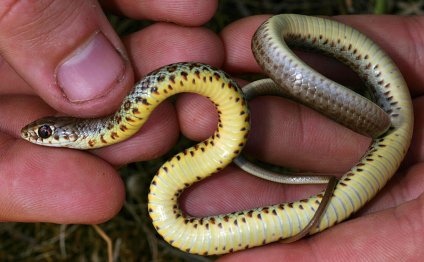
Small snake
 The popularity of ball pythons is due in part to their small size.
The popularity of ball pythons is due in part to their small size.
BananaStock/BananaStock/Getty Images
While large snakes can make impressive pets, most people do not have enough space for 6- or 8-foot-long ones. However, several species remain small and thrive in modest-size cages. Most king and milk snakes require only 3 or 4 square feet of cage space, and some boas and pythons are comfortable in cages of such size as well. For those seeking truly tiny pets, several insectivorous species pack a lot of personality into foot-long bodies.
Lurking in the Leaf Litter
Ringneck (Diadophis punctatus ssp.), brown (Storeria dekayi ssp.) and red-bellied snakes (Storeria occipitomaculata) are all very small species that inhabit the leaf litter of forests and suburban areas. Ringneck snakes are the largest of the group, sometimes approaching 18 inches in length; the other two species rarely reach 12 inches. These small snakes may have small fangs and weak venom to incapacitate their prey, but they are generally inoffensive, and regarded as harmless to humans. All three species feed on a variety of invertebrates; however, ringneck snakes consume small snakes and salamanders as well.
Miniature Milk Snakes
Several milk snakes and their close relatives remain relatively small. Most Mexican milk snakes (Lampropeltis triangulum annulata) are about 2 1/2 feet long, though they occasionally reach 3 feet. Scarlet king snakes (Lampropeltis elapsoides)—which were, until recently, considered a milk snake subspecies—are very small, rarely exceeding 20 inches in length. Unfortunately, many milk snakes primarily feed on lizards and may be difficult to switch to a rodent-based diet. Gray-banded king snakes (Lampropeltis alterna) and their Mexican king snake cousins (Lampropeltis mexicana ssp.) are also small species, and most stay under 3 feet long.
In the Rough
Rough green snakes (Opheodrys aestivus) are very thin snakes—though they reach 3 feet or more in length, most weigh less than 1 ounce. Rough green snakes are primarily arboreal, prowling and sleeping in shrubs and small trees. They are popular among many keepers for their insect-based diets; rather than mice and rats, rough green snakes prefer crickets and roaches. They are excellent display animals, but they do not tolerate frequent handling, and stress easily.
Considerable Constrictors
Though part of the same lineage as 400-pound anacondas (Eunectes ssp.) and 25-foot-long reticulated pythons (Python reticulatus), many boas and pythons stay quite small. Female Kenyan sand boas (Gongylophis colubrinus) are relatively small—usually under 3 feet—but males are even smaller, rarely exceeding 18 inches. Rosy (Charina trivirgata) and rubber boas (Charina bottae) of North America are also small, and average about 3 and 2 feet, respectively. Children’s pythons (Antaresia childreni) are spotted Australian snakes that reach about 3 feet. Ball pythons (Python regius) are capable of exceeding 4 feet, but are still quite manageable for most hobbyists.
RELATED VIDEO



Share this Post
Related posts
Colorful lizard
A very large species of chameleon that is endemic to forests in eastern and northern Madagascar. They reach up to 68 cm (27…
Read MorePet frogs for sale
Choose your dart frog Browse through our huge collection of captive bred dart frogs of all kinds and select one that you…
Read More











